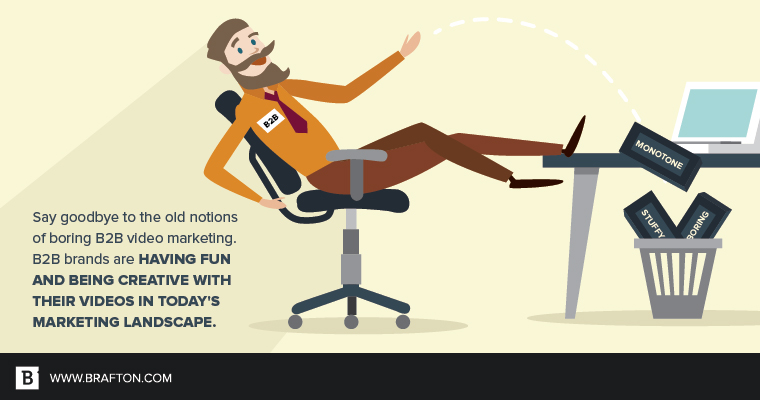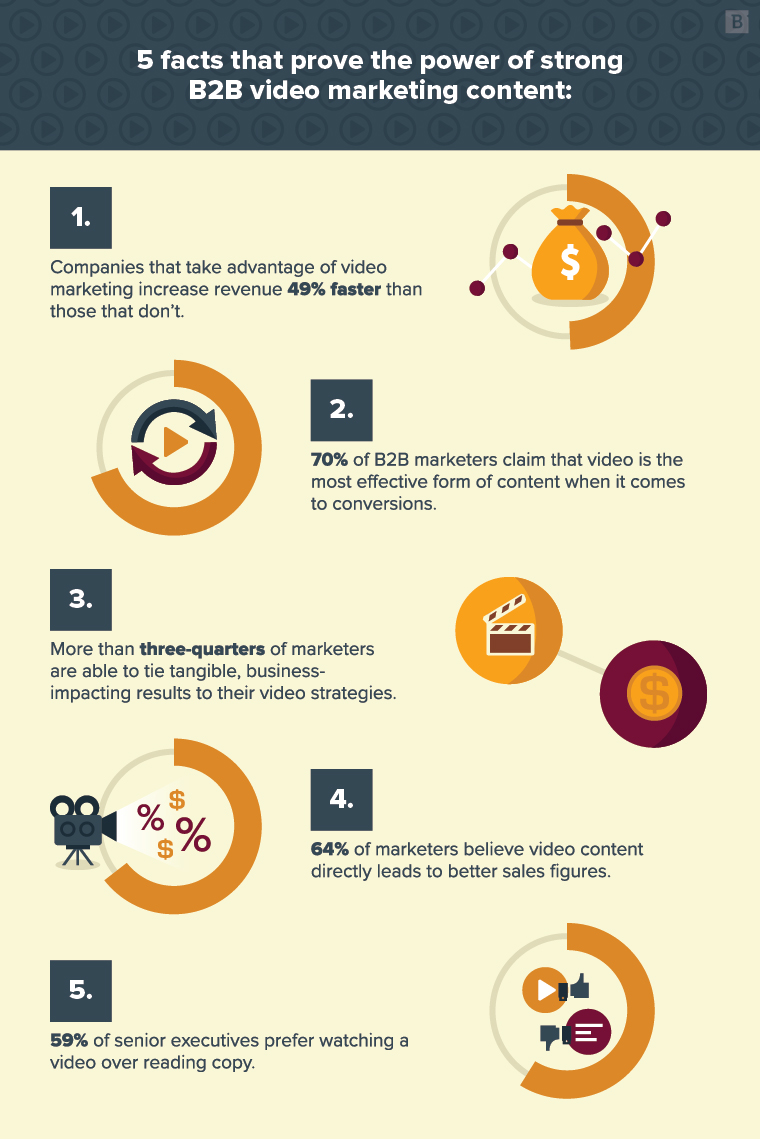If you don’t include video in your B2B email marketing strategy, you’re doing it all wrong.
Like blogs, white papers, infographics and social media, video should be a focal point of your digital marketing plan. Each one of those pieces of content serve their own purpose in the grander scheme of B2B email marketing, and video has its own role to play.
Whether they lack the time, money or talent to create compelling video content of their own, many companies let this critical cog in the marketing machine fall by the wayside. By doing so, these organizations lose out on a golden opportunity for engagement and building brand awareness.

Why video matters
Ask yourself, when you initially look up a potential business partner or vendor, is your very first step to spend hours perusing their library of white papers? No, of course not. That would be crazy. You read up on a few landing pages, maybe catch a blog or two and, if there’s a corporate promo or service overview demonstration, you watch a 1-2 minute video to get the company’s quick hits.
Video is just more engaging than other forms of content – when created with a professional, skilled eye, of course.

If you haven’t been completely sold on the power of strong B2B video marketing content, consider these facts:
- Companies that take advantage of video marketing increase revenue 49 percent faster than those that don’t.
- 70 percent of B2B marketers claim that video is the most effective form of content when it comes to conversions.
- More than three-quarters of marketers are able to tie tangible, business-impacting results to their video strategies.
- 64 percent of marketers believe video content directly leads to better sales figures.
- 59 percent of senior executives prefer watching a video over reading copy.
The takeaway here is pretty clear: Video just works better. If you’re looking to increase engagement metrics, drive lead generation and encourage conversions, a B2B video marketing strategy is absolutely essential.

Where B2B diverges from B2C video
B2B video marketing is a whole other animal than B2C strategies. When you think of successful consumer-focused videos, what comes to mind? Often, it’s funny, irreverent and even somewhat juvenile content. Obviously, that approach won’t fly with a B2B audience – most of them, anyway. You just can’t make poop jokes when marketing cloud services, regardless how well-woven they may be.
That’s not to say you can’t inject humor into your B2B video content when appropriate, but it shouldn’t be the focal point of your strategy. Comedy’s subjective, after all, and you’re just as likely to turn away potential customers with an aggressively funny video as you are to bring them into the fold.
More than that, though, B2C marketing is driven by emotion.
Companies want consumers to associate powerful, positive feelings and emotions with their brand. Hence, why the airwaves seem to get bombarded by overly sentimental advertisements every holiday season.
Or consider a recent Dodge Ram commercial that aired during a certain recent major sporting event. While the general response to that ad was negative, deeming it a tone-deaf attempt to take advantage of a revered civil rights leader’s image to sell pickup trucks, the underlying thought process of creating a deep emotional connection between the product and the spirit of community and unity is somewhat sound, if completely misguided.
Business audiences don’t think that way about investments and purchases, though. No one ever bought a license for a new software platform because they got swept up in the emotional resonance of its marketing campaign. They view potential acquisitions in cold, hard numbers and the sharp light of rationalization. We’re talking ROI here, people.
When you get down to it, B2B video marketing is all about highlighting brand value. If you can show potential customers how your product or service will increase their revenue, eliminate ongoing expenses, improve employees’ day-to-day tasks and responsibilities and just make their lives easier, then you have yourself a winning formula.
When you’re sitting down to create impactful B2B video content, keep these questions in mind:
- How does my product help increase client revenue or decrease operating expenses?
- Can that be tangibly measured and quantified?
- How does each feature improve day-to-day operations for my customers?
- What are my key differentiators and value-adds? Increased productivity? Low costs? Industry experience? Staff expertise?
It’s all about understanding your business audience and creating a sense of value so they realize that the long-term benefits of your product or service vastly outweigh any upfront investment.
The many faces of B2B marketing video
If you’re hoping to create one, catchall video to handle your marketing needs, you will be sorely disappointed. There are a variety of video content types out there – each one geared for a specific purpose and intent.
Animated explainers
Fantastic for giving overviews of your brand’s strengths and capabilities, animated explainers are fast-paced, breezy affairs that cover your value props without dwelling on any one particular area.
No dense feature lists here – keep things quick and engaging. You want to give potential leaders a general idea of what your business does and the value it can provide without getting bogged down in the nitty gritty details.
Animated explainers should be fun, dynamic and chock-full of verve. The idea is to grab your audience’s attention and convey the benefits of your products and services as quickly as possible. Give them the greatest hits of your competitive differentiators and get in and out before their flickering attention span draws them away to yet another GIF thread.
At this stage, you aren’t trying to win over a conversion so much as create awareness and get your audience thinking about your brand and value adds.
Product videos
Once your site visitors have a rough understanding of what your business does and the types of services it provides, they’re going to want more information about those specific offerings. This is where product videos come into play.
Product videos are fairly straightforward, showing off different features, tools and capabilities, as well as providing information about how each one translates into real business value. You want to make this content as clear as possible – don’t bog viewers down in a bunch of technical information and product specs, if you can help it.
Site visitors who view product videos are more likely to have reached the purchase decision stage, and are whittling down their options by comparing different features.
InVision’s product reel shows you how to approach these kinds of videos in a way that conveys the required information while still maintaining a dynamic tone and presenting the company as an exciting, forward-thinking industry disruptor.
InVision ties its solutions to broader industry trends as well as day-to-day problems they help address. It’s a very engaging piece of work, all around.
Case studies
If you have an incredible success story to share, by all means, get that out to the world. Case studies are useful for showcasing the work you’ve done with specific clients, highlighting your product features and the value they provide.
Case studies typically have a before-and-after format, showing the customer’s journey from struggles to eventual success. The goal here is to tell a fully formed story that details client pain points and how your product helped overcome them.
This content is great for lower in the sales funnel, when your leads have been sold on your overarching value proposition and want to know more about how your products and services look in action.
Slack, the near-ubiquitous cloud-based collaboration platform, is a good example of how brands can tell a cohesive story with their case studies and showcase value-adds – all while presenting a specific brand voice that’s all their own.
Take a look for yourself:
Testimonials
Great client-customer relationships should be celebrated, and video testimonials are a great way to do so. A common question people have is what, exactly, separates a testimonial from a case study? Testimonials are more focused on the customer experience and showcase client quotes and interviews accordingly.
Why go with a testimonial over a case study? Where a case study shows off the value you provide your customers, testimonials are all about the experience and the relationship. Potential clients want the full package, and that includes knowing that your staff will have their back every step of the way from implementation and initial configuration to ongoing day-to-day support.
While it’s good to harp on your customer experience chops yourself, sometimes sales prospects want to hear from actual existing customers in their own words. It’s one thing to have a company say it has an incredible support system in place – it’s another to have real customers back that claim up.
Like case studies, testimonials are extremely valuable toward the end of the decision-making process, when leads are determined to make a purchase but are still sifting through potential vendors.
This Zendesk testimonial demonstrates the impact that shifting your attention to the client can have. There’s no editorializing or interjections from the brand; it’s 100 percent focused on the customer and the brand experience from their point of view:
Instructional
Ideally, every single product and service would be pure plug-and-play solutions with low barriers for entry. That, sadly, is not the case in many scenarios, leaving some customers absolutely lost about how to configure complex platforms and set up new business solutions, much less get the most value out of them.
Instructional videos are a fantastic way to guide customers through your products, provide tips and tricks and educate them on how to configure your solutions for optimal results. That way, new clients don’t feel any sense of buyer’s remorse and can hit the ground running.
You can expand the use of instructional videos to target potential sales prospects, as well. By tackling a more general topic that affects your audience and showing them how to address industry-specific problems, you can cultivate thought leadership in your space. If you can find a natural, intuitive way to work your own solutions into the conversation, even better.
HubSpot has a pretty incredible example of instructional videos in action with this animation discussing artificial intelligence:
It tackles a trending, complex topic that is widely misunderstood and breaks it down into terms that can be easily understood by any layperson. HubSpot also creates a “so what?” moment, discussing not only what AI is, but how it will impact its audience.

Putting it all together
When applied to the right points of contact in the sales funnel, videos can be powerful tools of engagement. Once you’ve got a handle on the best types of video content for every scenario, you can craft a comprehensive B2B video marketing strategy that checks off every box and seamlessly guides prospects through the purchase process.
One thing’s for sure: If you’re still hesitant about investing in video marketing content, set those worries aside. The impact this material can have on engagement, lead generation and conversions is simply massive. Get a strategy place and start incorporating video into your B2B marketing campaigns today.
Have a favorite B2B video of your own? Feel free to share it in the comments section below.





